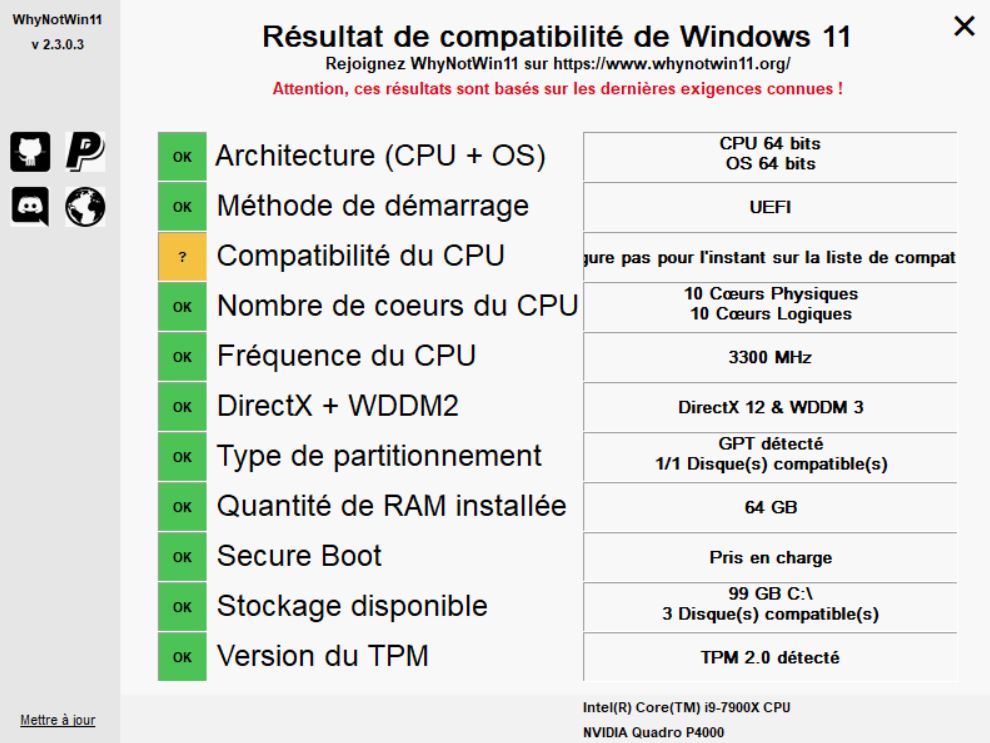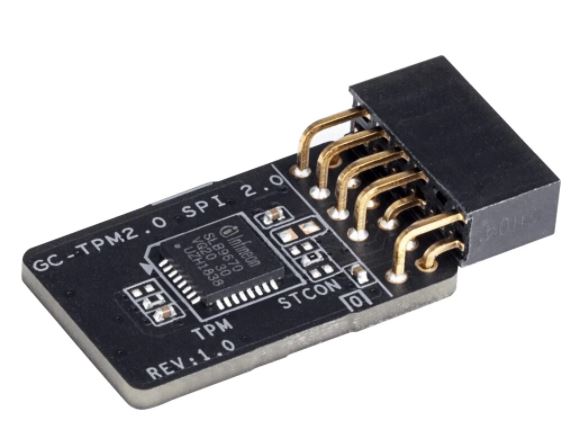 |
 |
Do you think your PC is incompatible with Windows 11? Or are you wondering whether my PC is compatible with Windows 11?
This online guide will save you the hassle of changing PCs, saving you money and protecting the environment at the same time.
Follow the 4 steps hereafter if you want to be aware of all the details, or straight to step 4 if you are sure your PC is not compatible and you don’t care why.
If you don’t feel easy with forcing Windows 11 installation on an incompatible PC yourself, contact us for a free Windows 11 diagnostic ou chose our Windows 11 package.
STEP 1: Check that your PC is Windows 11 compatible
Microsoft has put a » PC Health Check » online, which doesn’t necessarily give all the reasons when it declares a PC incompatible with Windows 11. You can try it on this page.
We prefer the WhyNotWin11 utility, which gives you all the details. What’s more, it’s a small stand-alone program that requires no installation. Download it here.

STEP 2: Interpreting the Windows 11 compatibility results
Here are the Windows 11 compatibility items that will enable you to make your pc natively compatible with Windows 11 by following the advice for each item, or to judge whether to continue with a forced upgrade.
- ArchitectureThere will be no 32-bit version of Windows 11So if your CPU is 32-bit, it’s definitely incompatible with Windows 11, so you can stop here.
If your OS is 32-bit, but your CPU is 64-bit, then you’ll need to start by upgrading your current Windows from 32 to 64-bit. Microsoft doesn’t know how to upgrade from 32 to 64 without losing data; you’d have to reinstall from 0, but we do know how to do this complete transfer, consult our package.
Note that even 64-bit Windows 11 will still run 32-bit applications. - Boot method and Secure BootThe computer starts up on a BIOS or UEFI (sometimes referred to as « BIOS UEFI »). If you don’t know what this is, there are HERE a good article on the subject. Very old PCs only have an old-generation BIOS and this is incompatible with Windows 11. However, as of 2006, some machines are UEFI-capable. In general, in the BIOS settings you’ll be able to choose between a « BIOS LEGACY » mode (old generation) and a « UEFI » mode (new generation). If your PC is from 2006 or later and you don’t see this choice, then start by updating your BIOS to the most recent version. If the most recent BIOS for your PC has no UEFI option, then it’s incompatible with Windows 11. The same goes for Secure Boot: if your UEFI has this option, enable it; if no Secure Boot option exists, it’s incompatible with Windows 11. See our switch from BIOS to UEFI and MBR to GPT without data loss.
- CPU compatibilityNumber of cores, frequency the processor should theoretically be in this official list. However, any 64-bit processor (see above), with a » disable bit « Already required for Windows 10, at least 2 cores and a frequency of at least 1 GHz could run Windows 11.
If you see a red tick here, it’s a bad sign and there’s a good chance that your computer remains incompatible with Windows 11. You can still try to force the upgrade by following our advice, then consider changing processor if your motherboard supports a compatible processor.
Fortunately, an orange tick is often displayed, meaning that the processor seems to meet the requirements but is not (yet) on the official list, and you can follow our advice to upgrade to Windows 11 anyway. - Direct X + WDDMThis has to do with the graphics card. If you have a laptop or all-in-one PC and a red tick here, it’s incompatible with Windows 11. If, on the other hand, you have a desktop or tower PC, chances are you can replace your graphics card with a newer, compatible model.
- Partition typeYour disk partitions are either GPT or MBR (old standard). Don’t panic, there are plenty of ways to convert MBR to GPT. Please note that most methods result in complete loss of data, but our explains how to switch from BIOS to UEFI and MBR to GPT without data loss. Either you already know how to do it, or don’t do it yourself – it’s a risky operation. Give us a call.
- RAM quantityYou need at least 4GB of RAM. In most cases, you can increase your RAM if you have less than 4GB. We make a free diagnosis to confirm this. You can also go to the Crucial website and use their system scanner which will tell you what RAM your system supports. If your PC can’t reach 4 GB, it’s incompatible with Windows 11.
- Available storageThis is just the amount of disk space available to install Windows 11. If it’s insufficient, chances are you can easily increase it. We make a free diagnosis to confirm this. go to the Crucial website and use their system scanner which will tell you what storage your system supports.
- TPM versionThe TPM is a hardware security chip, see this article. This will be the most frequent cause of incompatibility. However, before you assume that your PC is not equipped, check these points
- Google the name of your machine and TPM to find out if the TPM chip exists on your motherboard, or if it can be added (some motherboards have a connector for adding a TPM chip). If your machine clearly doesn’t have a TPM and it’s not possible to add it, then it’s incompatible with Windows 11. Here’s an example of an optional TPM chip to add to a motherboard

- If TPM is present or has been added, but remains inactive, update your BIOS to the latest version. Then look for the option referring to TPM (note that the name may be different, such as security chip, intel security device, PTT, and the BIOS section may be SECURITY or ADVANCED or other), and enable TPM.
- Google the name of your machine and TPM to find out if the TPM chip exists on your motherboard, or if it can be added (some motherboards have a connector for adding a TPM chip). If your machine clearly doesn’t have a TPM and it’s not possible to add it, then it’s incompatible with Windows 11. Here’s an example of an optional TPM chip to add to a motherboard
STEP 3: Use Windows 11 compatibility results
The results of this test will enable you to make the necessary adjustments to make your PC Windows 11-compatible, or even closer to it, because the more boxes you tick, the better it will be afterwards.
If you don’t understand the test results, or if you don’t want to force the installation of Windows 11 yourself, contact us for a free Windows 11 diagnostic.
If your PC can’t be made compatible with Windows 11, but you want to install Windows 11 on an incompatible PC yourself, click on the next step
STEP 3: What if my PC isn’t compatible with Windows 11?
If you don’t want to force Windows 11 installation on an incompatible computer yourself, contact us for a free Windows 11 diagnostic ou chose our Windows 11 package.